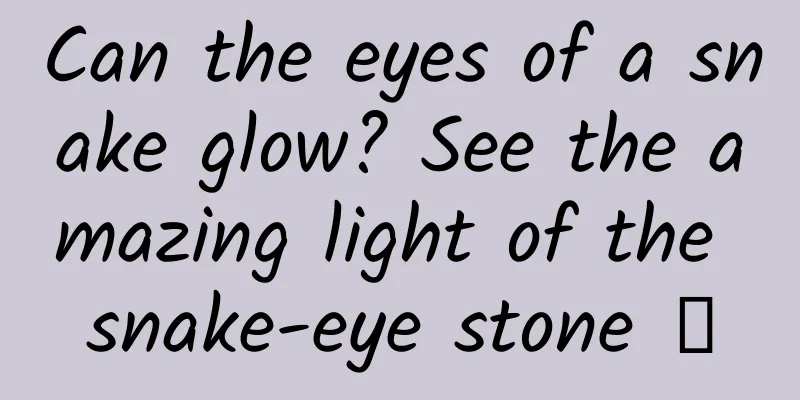Can the eyes of a snake glow? See the amazing light of the snake-eye stone →

|
On a dark and windy night, snakes danced wildly on the small hills, and a faint blue light flickered in the clouds and fog. The terrifying scene and mysterious light sparked all kinds of speculations! Is there a treasure hidden in the mountains? Or is it a murderous intention in the dark night? It is said that on a hill in ancient India, when night falls, people will find many poisonous snakes entwined around a large stone. And this large stone can actually emit a faint blue light. This strange phenomenon aroused the curiosity of local people, and this stone is also called snake eye stone. The "snake eye stone" that attracts snakes to gather (the picture comes from the Internet, please delete if it infringes) After research, the truth finally came to light... It turned out that there was a luminous mineral on the stone - fluorite. The light emitted by fluorite attracted flying insects with phototaxis, frogs came to catch the insects, and poisonous snakes followed closely, resulting in the phenomenon of poisonous snakes entrenching. Similar incidents have also been reported in my country. Green transparent fluorite specimens in the collection Fluorite is a mineral produced all over the world. Its main component is calcium fluoride. Its crystals are usually octahedral or cubical. It is rich in colors and very beautiful. Therefore, it was often used to make decorations in ancient times. It was given the word "firefly" because of its luminous properties. Octahedral single crystal specimen of fluorite in the collection Due to its large output and low hardness, fluorite is not a gemstone. Since the industrial age, it has been often used as a flux in smelting metals. Its mineral name "Fluorite" is also related to this. It comes from the Latin word "Fluere", which means "flowing". As a representative of luminous minerals, it prompted the birth of the term "Fluorescence". Fluorite crystal structure diagram (picture from the Internet, please delete if infringement) In fact, not all fluorites can emit light, and there are more than one type of mineral that can emit light. Common minerals such as calcite and gypsum, as well as precious minerals such as ruby and spinel, all have the potential to emit light. The reason why we say potential is that they need to meet certain conditions to emit light. Luminescence phenomenon of calcite specimens in museum collections Luminescence of ruby crystals in museum collections Energy from the outside world is the external condition for these minerals to glow. Self-luminescence does not exist. After all, "a good cook cannot cook without rice". Where do they get the energy they need? Collecting the spiritual energy of heaven and earth, receiving the essence of the sun and the moon... Of course, it is not so mysterious, but the ultraviolet light and heat energy in sunlight can indeed make minerals glow. Some minerals even have "masochistic" properties, and can obtain the energy to glow by hitting with blunt objects, rubbing on the ground, etc. A variety of luminescent minerals in the museum's collection under long-wave ultraviolet light This is not to encourage you to pick up a hammer and walk towards the trembling mineral specimens. To glow, minerals must have some unique internal conditions. First, they are highly tolerant. With their unique crystal structure, they are very tolerant of impurities, such as rare earth elements. Secondly, they are cheerful and lively. The lively impurities make up their lively character, so they will glow when stimulated by energy. 17 rare earth elements (pictures from the Internet, please delete if infringed) The duration of mineral luminescence varies. Some stop luminescence immediately after the energy is interrupted, which is called the fluorescence effect, while others can last for a period of time, which is called the phosphorescence effect. Some of these minerals have a particularly long duration of luminescence and are very rare. If they are rounded, they become night-shining pearls with high ornamental value. Even for fluorescent minerals, if many types are gathered in one room, the visual effect when they glow is also great. Night Pearls in the Museum's Collection Part of the Luminous Minerals Exhibition Hall |
<<: My skin is dry in winter, should I apply a facial mask every day?
Recommend
The efficacy and function of money tree root
Do you know about the root of the money tree? It ...
Is it good to make wine with deer antler and American ginseng?
Our bodies need health care and conditioning in n...
The efficacy and function of mountain pineapple root
Mountain pineapple root is a commonly used medici...
China Tourism Academy: Development of World Tourism and Leisure Cities
The report mainly focuses on four aspects: the hi...
FedEx: Unlocking Japan's e-commerce potential
FedEx released a new report, "Unlocking the ...
What are the effects of honey astragalus
If you want to make your body healthier, you must...
How does the brain recognize people by their voice?
Review expert: Yuan Xiandao, deputy chief physici...
The effect of Tianshuxin Kangfuxin liquid
The main function of Kangfuxin Liquid is to nouri...
The efficacy and function of wolfberry
As a traditional Chinese medicine, wolfberry has ...
Are health products becoming snacks? Can vitamin gummies help maintain health?
Song Ge Not long ago, the topic "Why can'...
Qian Xuesen's reply 23 years ago inspired the advent of quantum computers
On the morning of December 4, Guo Guangcan, an ac...
Is the ocean salty? This satellite tells you
At 6:42 on November 14, the Ocean Salinity Detect...
Harvard study: Eating one of these fruits a day reduces the risk of depression by 20% (not apples)
Compiled by: Gong Zixin Depression affects more t...
The efficacy and function of beech
The nutritional value of beech is rich and the me...









